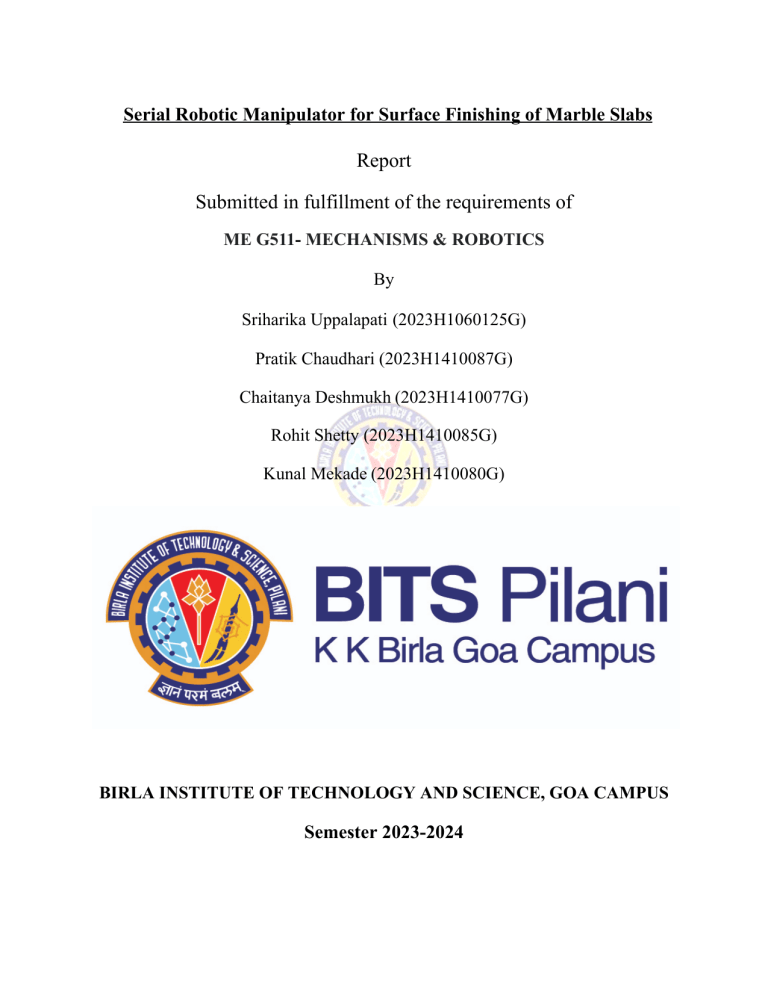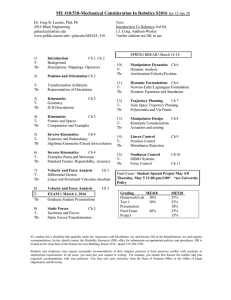
Serial Robotic Manipulator for Surface Finishing of Marble Slabs
Report
Submitted in fulfillment of the requirements of
ME G511- MECHANISMS & ROBOTICS
By
Sriharika Uppalapati (2023H1060125G)
Pratik Chaudhari (2023H1410087G)
Chaitanya Deshmukh (2023H1410077G)
Rohit Shetty (2023H1410085G)
Kunal Mekade (2023H1410080G)
BIRLA INSTITUTE OF TECHNOLOGY AND SCIENCE, GOA CAMPUS
Semester 2023-2024
Index
1.
2.
3.
4.
5.
6.
7.
8.
9.
10.
Introduction..............................................................................................1
Objective...................................................................................................1
Kinematics of Robot.................................................................................3
3.1. Forward kinematics
3.2. Inverse kinematics
Velocity Analysis.......................................................................................5
Study of Forces and Torques...................................................................9
5.1. Static analysis
5.2. Dynamic analysis
Trajectory Planning.................................................................................19
CAD Model...............................................................................................21
Selection of Actuators..............................................................................22
Selection of Polishing Wheel…………………………………………...23
Future Scope.............................................................................................24
INTRODUCTION
With all the strides made in the field of automation, these advancements have seldom reached
other facets of the economy. One such industry, for example, is the stone industry. During the
production of marble slabs, a coarse surface finish is obtained after the cutting and edge
elimination process. To obtain a smooth finish, the slabs need to undergo a surface finishing
process. In India, surface finishing cannot be carried out without an operator. This job is tedious
and puts undue strain on the operator's body. If automated, not only could it potentially eliminate
these hazards, it would increase the production rate and efficiency of the process.
This project aims to automate the surface finishing process of marble. By designing a robotic
manipulator with a buffing wheel fitted at the end effector a smooth surface finish can be
obtained.
A marble slab will be sent to the workstation using a conveyor. A fixed coordinate will be
specified to position the slab correctly. After securing the slab, the end effector will be lowered
to start polishing.
OBJECTIVE
The task mentioned above can be carried out with a robotic manipulator with 3P configuration
(as shown in Fig. 1). The specifications and configuration are as follows:
Robot Configuration:
PPP, Cartesian box/gantry configuration
Degrees of Freedom = 3
Range:
x-axis =1000mm
y-axis = 500mm
z-axis = 200mm
Workpiece dimensions: 1000*350*18 mm
1
Fig. 1 - Schematic representation of robot with PPP configuration for surface polishing,
along with a marble slab (in red)
KINEMATICS OF THE ROBOT
Forward Kinematics
Here, l is the length
of the end-effector
along the axis of
link-3
Fig. 2 - Link-Coordinate Diagram
2
Denavit-Hartenberg Table
i
𝞪i-1
ai-1
di
𝞡i
1
0
0
d1
0
2
90
0
d2
90
3
90
0
d3
0
tool
0
0
l
0
The general form of the Transformation matrix
=
Substituting the DH Parameters in the General Transformation Matrix
For i = 1
=
For i = 2
=
For i = 3
=
3
For tool,
=
Now,
For
=
By Solving the above equation,
We get,
=
Now,
For
=
By Solving the above equation,
We get,
=
Fig. 3
Scaled down to:
x-axis=10mm
y-axis=5mm
z-axis=2mm
4
Inverse Kinematics
Comparing the derived transformation matrix and comparing it to the standard matrix as given
below
=
We get,
x = l + d3
…… (i)
y = -d2
…… (ii)
z = d1
…… (iii)
ɸ = 𝞡1 +𝞡2 + 𝞡3 = 0 + π/2 + 0 = π/2
From the equations (i), (ii) & (iii),
We can get the values of d1, d2, & d3 in terms of x, y & z
d3 = x- l
d2 = -y
d1 = z
VELOCITY ANALYSIS
From the transformation matrix, we can calculate the linear and angular velocity propagation in
the links of the given serial manipulator with 3P configuration, using the following formulae:
Rotation matrices for the links,
5
For angular velocity,
For linear velocity,
For i=0
6
For i = 1
For i = 2
For i = 3
7
For i = Tool
Converting the vectors into base coordinate frame {O}
From the obtained linear and angular velocity vectors, we can obtain the Manipulator Jacobian
8
Where jacobian matrix [Jp] =
det[Jp] = 1
Since the derived Jacobian has a determinant value of 1 we can conclude that the chosen
configuration has no singularities and the end-effector can therefore move freely in the
prescribed workspace.
STUDY OF FORCES AND TORQUES
Static Analysis
To find the forces and torque acting on each link when the manipulator is at rest, we use the
following formulae,
Force on a link;
9
For i = 3
For i = 2
For i = 1
Moment acting on the on a link is given by;
For i = 3
10
For i = 2
For i = 1
These are the inward recursive forces and moments for each link of the manipulator.
To find the generalized force,
For i = 1
For i = 2
11
For i = 3
Therefore, the actuator force on each joint 1, 2, and 3 is given by τ1, τ2, and τ3 respectively.
Dynamic Analysis
Dynamics is the study of the motion of links due to external forces and torques.
Using Newton-Euler Recursive formulation, inverse dynamics can be carried out to obtain the
generalized forces acting on the joint.
Linear acceleration
The linear acceleration of the links can be found using Outward Iteration. The angular velocity of
the links was found to be zeros. This is because the links are prismatic and therefore do not
experience angular velocity.
Linear acc of prismatic joints;
From velocity analysis, the angular velocity of each link is zero.
12
Therefore,
For i = 0
For i = 1
13
For i = 2
Acceleration of Center of Mass
Since the angular velocity and acceleration were found to be zero, this equation can be
rewritten as;
For i = 0
For i = 1
14
For i = 2
Forces and moments
From the derived values of velocity and acceleration, we can obtain the forces and moments
acting on the links using;
Forces acting on links
For i = 3
For i = 2
15
For i = 1
Moments acting on the links;
For i = 3
For i = 2
16
For i = 1
Adding static and dynamic force vectors,
For i = 1
17
For i = 2
For i = 3
We can now find the generalized actuator force acting on each joint using the following formula;
For i = 1 => Joint 1
For i = 2 => Joint 2
18
For i = 3 => Joint 3
TRAJECTORY PLANNING
Trajectory planning can be defined as generating a schedule for following a path given
constraints such as position, velocity, and acceleration.
From the joint space technique, we obtain polynomial equations that can describe the position
and orientation of the end-effector.
The polynomial equations are as follows,
For position;
d1(t) = 30 + 9.58 t2 - 0.44 t3
d2(t) = -130 -73.84 t2 + 17.04 t3
d3(t) = -150 - 40.75 t2 + 15.28 t3
For velocity;
v1(t) = 19.16 t - 1.32 t2
v2(t) = -147.88 t - 51.09 t2
v3(t) = -81.5 t + 91.5 t2
For acceleration;
a1(t) = 19.16 - 2.64t
a2(t) = -147.68 - 102.18t
a1(t) = -81.5 + 91.5t
From the above equations, the trajectory can be found.
19
Table 1 - The joint coordinates with respect to the end effector varying from time 0 to 2 sec, in
steps of 0.1 sec.
20
CAD MODEL
From the analysis conducted, the specifications and dimensions of the serial manipulator were
obtained. Using Catia V5 a 3-dimensional model of the manipulator has been drafted (fig.3)
Fig. 4 - 3D Model of 3P Serial Robotic Manipulator
21
SELECTION OF ACTUATORS
The moment of the links is propagated with the help of actuators. For the static and dynamic
analysis, the actuator force was found. Using these equations, actuators can be selected for the
joints.
For this manipulator, a stepper motor is chosen. Since the joints are prismatic and only undergo
translation motion
Motor specifications:
Size: 42.3 mm square × 48 mm
Weight: 350 g
Shaft diameter: 5 mm
Step angle: 1.8° (200 steps/revolution)
Current rating: 1.2 A per coil
Voltage rating: 4 V
Holding torque: 3.2 kg-cm (44 oz-in)
Maximum radial force: 28 N
Maximum axial force: 10 N
Fig. 5 - Stepper motor, SY42STH47-1206A
22
SELECTION OF POLISHING WHEEL
For the project, a polishing wheel of the following specifications is chosen;
Grinding Specifications
Diameter: 100-115-150mm
Hardness: Soft
Attachment: M14
Fig 6 - Polishing wheel
23
FUTURE SCOPE
-
A Finite Element Analysis can be conducted to study the stress and deformation of the
links at static state.
Further, a simulation model can be created to study the motion of the links.
A prototype of the manipulator can be fabricated with the given dimensions and
specifications
_______________________________________________________________
24



